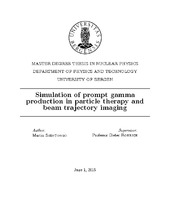| dc.description.abstract | In cancer oncology, using of Mega electron Volt (MeV) bremsstrahlung photons has been clinically practised on cancer patients since photons can deliver a significant dose to tumour volumes when projected into the body in several beam directions as in techniques such as Intensity Modulated Radio Therapy (IMRT) and Volumetric Modulated Arc Therapy (VMAT). However, photons in a single beam deposit their maximum energy just a few millimetres at the beam's body entrance and a decreasing dose deposition beyond the tumour site. Cancer research and clinical practice have resorted to use of charged particles like protons and carbon ion beams for cancer therapy since they deposit a large fraction of their energy at their extreme range in a Bragg peak with very less dose deposition after the Bragg peak targeted to the tumour. This ensures maximum dose to tumour for therapy and spares organs at risk in both forward and behind the clinical target volume. The intention of this study is to demonstrate the feasibility of prompt gamma imaging for the on- line verification of the Bragg peak position. In order to achieve this aim, interactions of 160 MeV proton and 300 MeV/u carbon ion pencil beams within a soft tissue phantom were simulated. Monte Carlo simulations based on FLUKA, have been performed to analyse prompt gamma radiation produced as a result of inelastic nuclear interactions during both proton and carbon ion therapy procedures. These simulations were performed with a main view of designing a prompt gamma imaging device utilizing Compton scatter events and photoelectric effect processes of gamma radiation for real time control of incident beam during hadron therapy. Such a gamma detector system is called a Compton camera which has potential to utilize high energy photons emitted out of patients during hadron therapy which has long been a constraint in Anger cameras as they are only capable to image low energy photons of about 140 keV in Single Photon Emission Computed Tomography (SPECT). In this project, two chief objectives were to be achieved and these were: first, to present the physical and interaction characteristics of both primary beam and secondary radiation like protons, neutrons and more so prompt gammas by their angular distribution after their production and photon energy spectrum as a result of de-excitation of the different atomic nuclei of human soft tissue. The fine energy loss and inelastic nuclear interactions with tissue nuclei for both 160 MeV proton beam and 300 MeV/u carbon ion beams as they traverse through human soft tissue have also been included in these studies. The second objective which was divided into two sub-tasks was; to simulate the imaging performance of first, a High Purity Germanium (HPGE) Compton Camera and second, a single scattering Compton camera made up of a sub-detector system of silicon to act as a photon scattering detector and a germanium absorber detector. Primary beam range and photon source distribution were investigated using an iterative algorithm for reconstruction of cones using Compton scatter angle and energy deposition at Compton scattering and photoelectric effect positions in each Compton camera since reconstructed cones carried position and directional information of emitted prompt gamma radiation. Results from the first task of this project showed that prompt gammas from soft tissue nuclei de-excitation were emitted isotropically in all directions for both proton and carbon ion simulations of 1x10^7 primaries with distinct peaks at 2.3 MeV, 3.6 MeV, 4.4 MeV, 5.3 MeV and 6.2 MeV which corresponded to 14^N, 20^Ca, 12^C, 14^N and 16^O atomic nuclei de-excitation photon energies respectively. For a HPGE Compton camera of dimensions 32cmx8cmx32cm placed 8 cm to the top of the soft tissue phantom at orthogonal angle to the incident primary beam, data acquisition was done using gammas first Compton scattered within the detector and secondary photo-absorbed in the same germanium crystal. Only two successive interaction events were considered with a major assumption that the scattered quantum photon was completely absorbed at its second and last interaction in the germanium crystal. The number of secondary radiation that reached the detector included neutrons, electrons, positrons, protons and photons. Photons were Compton scattered in the angular range from 0<degrees> to 180<degrees> with low energetic photons scattered in angles greater than 90<degrees>. The energy spectrum of photons before Compton scattering showed an energy range from 0.1 MeV to 1.6 MeV with a sharp peak at 0.2 MeV in the 160 MeV proton beam simulation. This peak was shifted to 0.18 MeV in the 300 MeV/u carbon ion simulation and both simulations exhibited a 0.511 MeV photon peak. The angular resolution of the detector measured by angular resolution measure showed that ARM values of less than 3 mm would give better photon source predictions with a clear distinct primary beam range at 16 cm depth into human soft tissue using the germanium block Compton camera while as when using the single scattering Compton camera, the ARM values less than 6 mm accurately predicted the prompt gamma production distribution in the soft tissue phantom. Comparing the HPGe Compton camera with single scattering Compton camera in terms of photon energy range optimization for Compton cone reconstruction, the single scattering Compton camera proved to be better than the HPGe detector since it utilized photons from 0.03 MeV to 3 MeV for Compton cone reconstruction and yet the HPGe Compton camera only used a short energy from 0.1 MeV to 1.6 MeV. But single scattering Compton camera reconstruction results were affected by Doppler broadening as photons of energies less than 0.1 MeV were inclusive in the energy spectrum. The single scattering Compton camera was further found to have a better overall efficiency of 0.07% over that of HPGe Compton camera which was 0.032%. For both Compton cameras, the reconstruction source distribution tracked the original photon production distribution at the distal fall off by a precision of 0.1 mm. | en_US |
